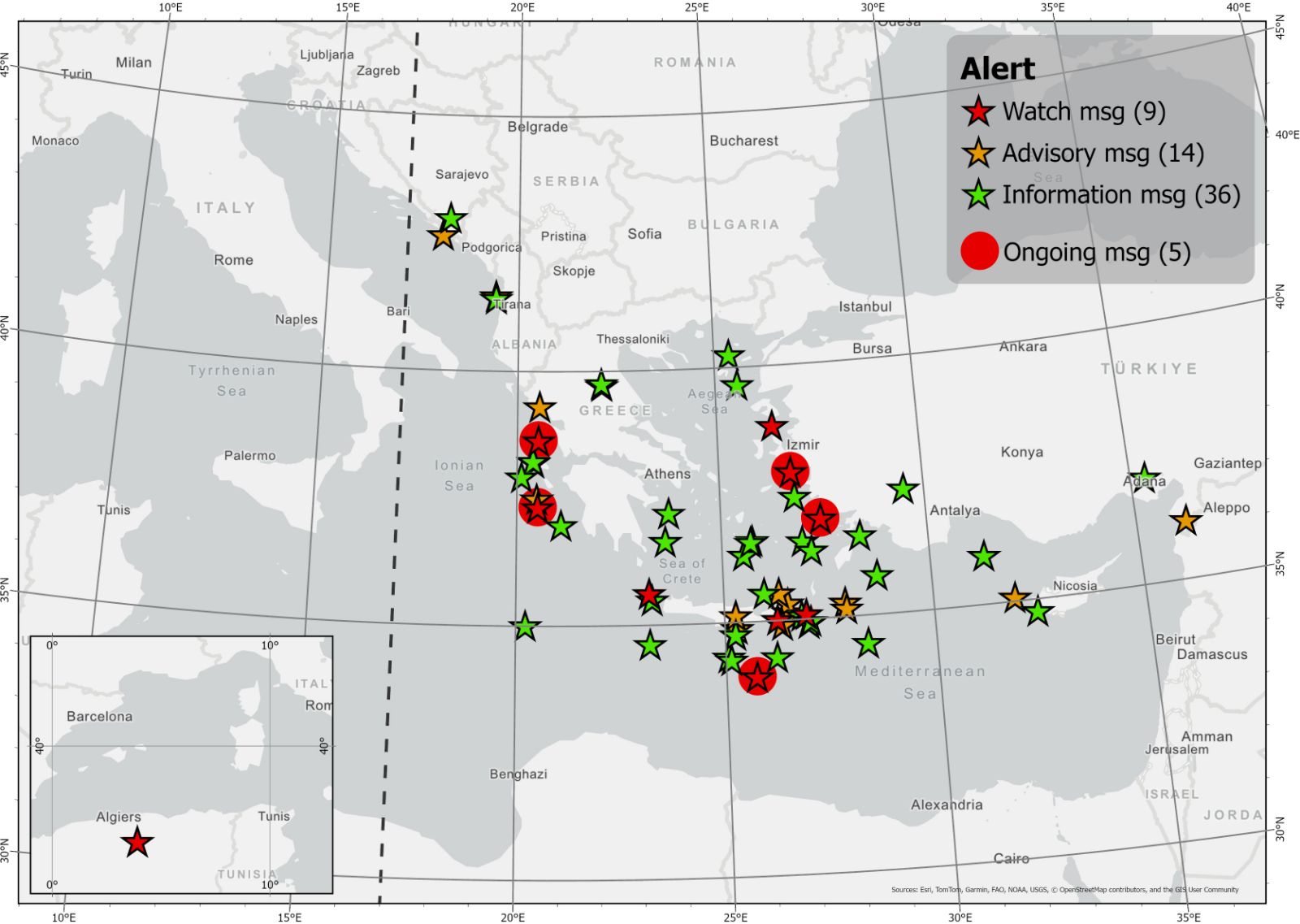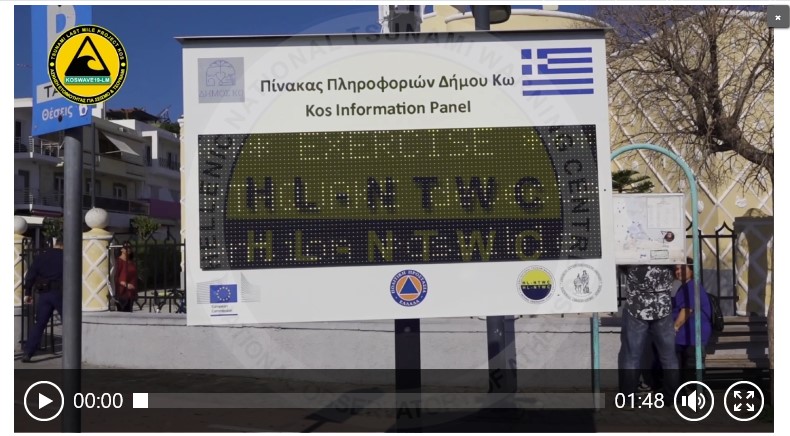Tsunami Warning Services
Alerting Procedure
The procedure which is followed to issue tsunami alerting messages by the HL-NTWC follows the standardization adopted by the ICG/NEAMTWS.
- As soon as an earthquake of minimum magnitude 5.5 has been generated under the sea or close to the coastal zones, the HL-NTWC analyses the earthquake focal parameters, i.e. the earthquake origin time, epicentre, focal depth and magnitude which are obtained by the NOA-IG’s automatic system within about 3 min from the earthquake origin time.
- Since immediately after the earthquake it is not known if a tsunami has been really generated or not, a tool which is called “Decision Matrix-DM” is used to decide the type of tsunami message that should be formulated and disseminated. A DM tool is a set of empirical rules, regarding the possibility for a tsunami to have been generated or not according to the location of epicentre, the focal depth and magnitude.
- After technical discussions within the working groups that support the ICG/NEAMTWS, with the active contribution by HL-NTWC experts, it was decided that two similar in their structure but different in the numerical values DM tools are appropriate to use, one for the North East Atlantic region and another for the Mediterranean basin. In Table 1 one may see that the tsunami severity predicted by the DM scales with the magnitude rangerange ‐ this DM replaced the original used by HL-NTWC effective 1 March 2021. As a consequence, 3 levels of tsunami messages could be produced with the increase of the wave severity: Tsunami Information, Tsunami Advisory, Tsunami Watch.
- At the same time, the magnitude range determines also the maximum distance at which tsunami impact is likely to be caused. From this point of view in the Mediterranean we consider Local (up to 100 km), Regional (up to 400 km) and Basin-Wide (beyond 400 km) tsunami message types. The assessment of the possible tsunami wave severity is summarized in Table 2.
- The DM can provide only a very gross approximation of what are the tsunami features that one may expect after a strong submarine earthquake. Therefore, a revised version of DM in the eastern Mediterranean is under elaboration by the HL-NTWC.
- However, the interest is not restricted only in making decision if a tsunami has been potentially generated and to assess its overall severity. It is also of alerting importance to compute the arrival time of the first tsunami wave in a number of coastal forecast points that have been determined officially by the NEAMTWS country-members. Therefore, besides earthquake focal parameters, a standardized tsunami alerting message informs the recipients about the type of message, using combinations between the various severity types (Information, Advisory, Watch) and the types of possible impact distance (Local, Regional, Basin-Wide), as well as the calculated arrival time in a number of officially prescribed forecast points.
- At the present stage of development the HL-NTWC and the other Tsunami Service Providers (TSPs) of NEAMTWS has set time 10 min. from the earthquake generation as target time for the release of tsunami messages. The actual times, however, vary below or above the target time depending on several factors.
- The next step in the alerting procedure is to collect, record, process and analyse sea level data for confirming and monitoring the tsunami or for cancelling the alert message. If a tsunami occurrence has been confirmed, then the tsunami message should be updated with the relevant information and resend as soon as possible. If needed, this procedure may repeat more than once. If, however, no tsunami generation is confirmed, then a tsunami cancellation message is issued and disseminated.
- It is noteworthy that no responsibility areas have been determined for the HL-NTWC and the other TSPs of NEAMTS. Therefore, sending and receiving tsunami messages is performed on a subscription basis.
- The central DM in use by HL-NTWC does not cover the Corinth Gulf, Central Greece, although the frequency of local tsunami generation is relatively high there (Papadopoulos, 2003b; Stefatos et al., 2006; Tselentis et al., 2006). The reason is that the Corinth Gulf covers an isolated sea area being of about 115 km in length and of 30 km of maximum width. However, a special DM was elaborated in-house and put in force in September 2016 aiming to close this gap in the tsunami warning operations in Greece.
- NEAMTWS, and consequently the HL-NTWC, operate only for tsunamis generated by earthquakes. Tsunamis caused by aseismic landslides or volcanic processes are beyond the current operation status of NEAMTWS.
Tsunami message dissemination
Tsunami message dissemination is achieved through a scripting that has been developed in-house, following the TAT messaging output. This gives the user the opportunity to send simultaneously two types of messages, i.e. e-mail and GTS (Global Telecommunication System), the last through the Hellenic National Meteorological Service (HNMS) via the dedicated VPN link between HNMS and HL-NTWC operating centres.
The e-mail message dissemination employs an e-mail server, which is always automatically synchronized for accurate time to UTC via local NTP server, and the available list of predefined recipients.
The SMS technology has also been used during tsunami exercises (e.g. NEAMWAVE14 & NEAMWAVE17) and the extended Communication Tests performed in the frame of the NEAMTWS (see Communication Tests and Exercises).
Tests and Exercises
- Tsunamis are infrequent events, therefore all agencies involved in tsunami warning and mitigation must keep a high level of readiness. In order to be able to maintain such an operational level of readiness, the tsunami centres, officers and emergency agencies should regularly practice their response procedures to ensure that vital communication links work flawlessly, and that agencies and response personnel are aware the roles that they have to play during an actual event.
- To this aim, HL-NTWC participates in monthly communication tests and exercises organized by the ICG/NEAMTWS/IOC/UNESCO, in order to periodically verify and keep its readiness. Every first week of each month, it conducts regular communication tests and participates in tests that are organized by other TSPs. Also, the HL-NTWC effectively conducted the 3rd and 6th Enlarged Communication Test Exercises in October 2013 and July 2015, respectively, with the participation of 31 counties and 40 agencies.
- Under the coordination of ICG/NEAMTWS/IOC/UNESCO, extended system testing exercises are also conducted based on pre-simulated tsunami scenarios. The HL-NTWC successfully participated in the NEAMWAVE12 exercise (November 2012), the first Tsunami Exercise in NEAM region, providing a scenario based on the 9 July 1956 Amorgos large tsunami (e.g. Okal et al., 2009).
- In October 2014, it also provided one of the four scenarios for NEAMWAVE14. The provided simulation was about the AD 21 July 365 western Crete large earthquake and tsunami event (e.g. Shaw et al., 2008) and was employed by the Emergency Response Coordination Centre of the European Commission (EC-ERCC) as an opportunity to test the internal procedures at the Union Civil Protection Mechanism (UCPM) and assess the capability of planning and activating the procedures for provision of international assistance to those affected countries which request it.
- On April 2016 the HL-NTWC, along with the tsunami centres of INGV and KOERI, joined a tsunami emergency exercise organized by the Israeli Emergency Authority. HL-NTWC provided an earthquake and tsunami scenario based on the large historical event of 8 August 1303 in the eastern segment of the Hellenic Arc.
- In collaboration with the public broadcasting system ZDF (Germany), the HL-NTWC acting in the frame of the ASTARTE project, organized a tsunami evacuation exercise in the coastal zone of Heraklion, capital city of Crete Isl., which took place on 12 April 2016. With the participation of 30 volunteers of the local Red Cross Organization, it was evaluated how the volunteers evacuated effectively after a tsunami warning message. ZDF performed shooting for the needs of a documentary about tsunamis in the European-Mediterranean region.
- In October 2017 the HL-NTWC joined for a second time in a tsunami emergency exercise organized by the Israeli Emergency Authority. HL-NTWC provided tsunami warning messages for the Israeli Emergency Authority in advance of NEAMWAVE17, in order to assist NEMA (Israel) in executing an extended drill exercise, based on the NEAMWAVE17 scenario.
- The HL-NTWC effectively participated in the NEAMWAVE17 exercise (November 2017). The scenario that was provided for the exercise was prepared jointly under the collaboration of CAT-INGV and NOA–HLNTWC and refers to a tsunami event affecting the eastern Mediterranean Sea, based on an earthquake of magnitude 8.5 occurring south of Zakynthos Island, in the western segment of the Hellenic Arc, which is a very active geodynamic structure. It should be noted that this was the first time that two TSPs, INGV & NOA, executed one single scenario, but issued their own tsunami warning messages regarding this joint scenario.
- The HL-NTWC organized and participated in an earthquake and tsunami preparedness exercise in the city of Kos, Greece, that took place on 19/11/2019. The exercise with title “KOSWAVE19-LM” was co-organized by the Municipality of Kos, the Institute of Geodynamics of NOA and European Commission Joint Research Centre, as part of the ‘Tsunami Last Mile’ project. The Tsunami Last Mile Project was proposed by the European Commission to test technologies and procedures that target the problems observed during the recent tsunami of 21st July 2017 that hit the city of Kos with a wave of about 1.5 m. The participants of the exercise included officials from the Municipality of Kos, local civil protection and emergency operations agencies, volunteer groups, the HL-NTWC, the Joint Research Centre, the General Secretariat for Civil Protection, and two schools in Kos. Mr. Nikos Chardalias, Secretary-General of the Greek Civil Protection was present, as well as officials from the General Secretariat for Civil Protection, the Directorate General for European Civil Protection and Humanitarian Aid Operations (DG-ECHO) and the Italian Civil Protection. The exercise tested the functionalities of the innovative "Tsunami Last Mile" Early Warning System installed in the city of Kos, its integration into the standard operational procedures of the Municipality, and the interconnection of the local system with the functions of the HL-NTWC in Athens. A video for the exercise can be accessed through this link.
- The Municipality of Eastern Samos and the Institute of Geodynamics of the National Observatory of Athens organized an earthquake and tsunami preparedness exercise on November 7, 2023, in the city of Samos, under the code name “SAMOSWAVE23-CW”. The exercise was part of IOC-UNESCO's regional exercise “NEAMWave23”. It was carried out within the framework of the “CoastWAVE” project, coordinated by IOC-UNESCO and funded by DG-ECHO of the European Commission. The purpose of the exercise was to enhance the operational preparedness of involved stakeholders at the local, regional, and national levels, as well as to improve the city's readiness in the event of a tsunami. The exercise also contributed to raising public awareness and informing the population, in the context of World Tsunami Awareness Day. Participants included, among others: the Municipality of Eastern Samos, the Regional Unit of Samos, local civil protection operational agencies, volunteer groups, the HL-NTWC of the Institue of Geodynamics, the General Secretariat for Civil Protection (GSCP), the Earthquake Planning and Protection Organization (EPPO), as well as two schools in Samos. Specifically, a tabletop exercise was conducted to test the emergency planning and evacuation plan developed for the city of Samos as part of the CoastWAVE project, as well as to test the mechanism for receiving and disseminating tsunami warning messages. Additionally, an earthquake and tsunami preparedness drill was conducted at the 1st Experimental Junior High School of Samos and the 2nd Junior High School of Samos. During the simulated earthquake, students and staff followed self-protection measures. Afterwards, upon receiving the exercise alert message via cell broadcasting (1-1-2), they proceeded along a predetermined route to the nearest designated safe assembly area, where they remained until notified that the danger had passed. A video for the exercise can be accessed through this link.



